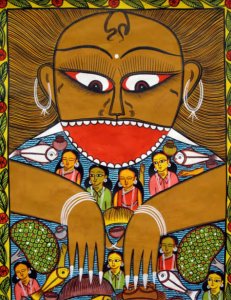Traditional Bengal Pat
Bengal Pat is one of the old styles of painting. The art named Bengal Pat is slang for Bengal ‘Patachitra’. It is an art form that was found and developed in the Indian state of Bengal which is why it is called as Bengal Pat. It is an art form that is practiced for hundreds of years. This traditional art culture is followed in parts of Bangladesh as well as in the state of Odisha.
“Patachitra” translates to “scroll painting” in Sanskrit, where “pata” means canvas or cloth, and “Chitra” means picture or painting. This art form holds a significant place in the cultural heritage of Bengal and has been practiced for centuries. The artist of Bengal Patachitra is called Patua.
This art form usually depicts a story or a song about the medieval and ancient ages. In this art called Bengal Pat, the paintings were usually made on the songs sung on the streets about the past events and incidents of the places, the gods and goddesses, and the folk culture of ancient history. Mainly, the Vaishnava and Jagannath sect has inspired this tradition. Thus, the present depiction of Lord Jagannath is taken from the Patta style.
The Patachitra of Bengal has four divisions which include Durga Pat, Chalchitra, Tribal Patachitra, Medinipur Patachitra, and Kalighat Patachitra. The Pata shares Hindu mythological stories from Ramayana, Mahabharat, and Puranas. It depicts the picture of Gods and Goddesses.
Durga Devi God’s Bengal Pat

The paintings depict the stories that were sung on the streets the songs that balladeers sang on the streets about the past events and incidents of the places and also about the wars, fights, Kings and their kingdoms, incidents, and tragedies in the form of ballads and songs.
But the paintings mostly depicted the times of the society and the folk culture of the place. The picture makers are the Chitrakars who drew the Goddess and stories revolving around it are with passion and respect to the deity and Hindu mythology. They pour out their visualization and heart to give the story depicts realness in the paintings.
The stories; the singers and folk dancers had started to be depicted in the form of paintings on scrolls of cloth so that they can be preserved and stored safely for future generations.
So that they too know and so the stories and incidents won’t be forgotten. Over time, the art form evolved, incorporating different themes and techniques, and even embracing contemporary subjects.
Singers and folk Bengal pat

The paints used in this art are made From spices, leaves, flowers, earth, soot, etc. Most of the paintings only used the traditional colors of Bengal. The traditional colors of Bengal are red, green, black, indigo, deep yellow to orange, and brown. Almost all the paintings had a tint of deep red and orange or brown in it.
Even to date, this art is admired by many and the main attraction of the Bengal Pat is that the artist talks about the real stories and incidents that took place.
You would be surprised as the Patachitra of Naya village in West Bengal is now collected in the National Museum of Ethnology ie. MNE, Lisbon
Preservation and Revival
In recent years, efforts have been made to preserve and revive the Bengal Patachitra tradition.
Artisans and organizations are working together to promote and sustain this art form, not only through the creation of new paintings but also by conducting workshops and exhibitions to showcase the richness of this cultural heritage.


